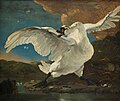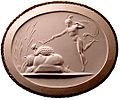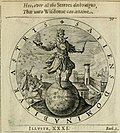The humanist scholar Gabriele Faerno, also known by his Latin name of Faernus Cremonensis, was born in Cremona about 1510 and died in Rome on 17 November...
14 KB (2,013 words) - 12:22, 7 May 2024
times, a number of Neo-Latin poets used it as a subject, including Gabriele Faerno (1563), Hieronymus Osius (1564) and Candidus Pantaleon (1604). The...
44 KB (5,782 words) - 14:54, 26 October 2024
collections of fables in verse, among which the most influential was Gabriele Faerno's Centum Fabulae (1564). The majority of the hundred fables there are...
102 KB (12,842 words) - 05:11, 20 October 2024
tales, he translated the Fabulae Centum (100 Fables) of the Latin poet Gabriele Faerno into French verse in 1699. Antoine Galland Alexander Afanasyev Brothers...
23 KB (2,653 words) - 14:35, 17 October 2024
East German gymnast Gabriele Faerno (died 1561), Italian writer Gabriele Falloppio (1523–1562), Italian anatomist and physician Gabriele Ferretti (1795–1860)...
12 KB (1,484 words) - 12:02, 26 May 2024
John Lydgate Kawanabe Kyōsai Laurentius Abstemius Roger L'Estrange Gabriele Faerno Hieronymus Osius Marie de France Robert Henryson Jean de La Fontaine...
6 KB (732 words) - 00:22, 25 August 2024
John Lydgate Kawanabe Kyōsai Laurentius Abstemius Roger L'Estrange Gabriele Faerno Hieronymus Osius Marie de France Robert Henryson Jean de La Fontaine...
19 KB (2,007 words) - 16:44, 22 October 2024
also been ascribed to the philosopher Socrates. The Neo-Latin poets Gabriele Faerno and Hieronymus Osius both wrote poetic versions, as did Jean de la...
6 KB (717 words) - 07:30, 27 August 2024
John Lydgate Kawanabe Kyōsai Laurentius Abstemius Roger L'Estrange Gabriele Faerno Hieronymus Osius Marie de France Robert Henryson Jean de La Fontaine...
5 KB (636 words) - 17:02, 16 October 2024
writers, Andrea Alciato in his Emblemata (1534) and the Neo-Latin poet Gabriele Faerno in his collection of a hundred fables (Fabulum Centum, 1563). Alciato...
37 KB (4,790 words) - 15:14, 25 October 2024
the Perry Index and is the one followed by such Neo-Latin writers as Gabriele Faerno and Hieronymus Osius and in English by Geoffrey Whitney. This alternative...
12 KB (1,742 words) - 14:19, 25 August 2024
cat) in 1499. A more popular version in Latin verse was written by Gabriele Faerno and printed posthumously in his Fabulae centum ex antiquis auctoribus...
17 KB (2,080 words) - 21:33, 24 August 2024
the subject of two Latin poems by Hieronymus Osius and another by Gabriele Faerno. In the contemporary Fables d'Esope by Gilles Corrozet (1547), as in...
7 KB (899 words) - 15:34, 7 October 2024
bibistis: tempus abire tibi est). In the Renaissance, the neo-Latin poet Gabriele Faerno included the version told of a fly in his Centum Fabulae (1563), ending...
3 KB (360 words) - 03:30, 25 August 2024
17th century. Hieronymus Osius devoted a Neo-Latin poem to it, as did Gabriele Faerno. The latter ends with the moral that "desert must be proved by deeds"...
9 KB (1,052 words) - 01:41, 25 August 2024
it was the fable of the Crow and the Snake that had been chosen by Gabriele Faerno for his collection of a hundred fables in Neo-Latin verse, with the...
7 KB (829 words) - 20:14, 10 September 2024
version has six pentameter lines, of which two draw the moral, and Gabriele Faerno's Latin reworking has five lines and two more drawing the moral. Both...
22 KB (2,503 words) - 15:34, 7 October 2024
Neo-Latin poems based on it were written by Hieronymus Osius and Gabriele Faerno in the 16th century, while in England it was included in Geoffrey Whitney's...
4 KB (550 words) - 03:03, 25 August 2024
there were 16th century poetic versions of the fable in Neo-Latin by Gabriele Faerno and by Hieronymus Osius. The latter concludes with the sentiment that...
3 KB (349 words) - 07:30, 27 August 2024
gazing up at the stars, falls backward into a pond. The Neo-Latin poet Gabriele Faerno also included the story of the stumbling astrologer in his collection...
7 KB (784 words) - 00:58, 25 August 2024
household effects. The story was rendered into Latin by the Papal scholar Gabriele Faerno and appeared in his collection of a hundred fables (1563) under the...
3 KB (406 words) - 16:32, 25 August 2024
The same story is told among the "100 Fables" (Fabulae Centum) of Gabriele Faerno (1564) and as the opening poem in Giovanni Maria Verdizotti's Cento...
20 KB (2,550 words) - 05:20, 1 October 2024
included the French author Gilles Corrozet (1547) and two Italians, Gabriele Faerno (1564) and Giovanni Maria Verdizotti. In Heinrich Steinhowel's 1479...
27 KB (3,406 words) - 17:09, 25 August 2024
in an emblematic way. They include Latin versions of the fable by Gabriele Faerno, whose De Canis & Caro warns not to prefer the uncertain to the sure...
15 KB (1,934 words) - 10:27, 2 October 2024
chariot during a race and comments on how much dust it is raising. Gabriele Faerno included it in his own Centum Fabulae (1563), giving the impression...
11 KB (1,412 words) - 15:35, 25 August 2024
statement "that music is so powerful that it can even avert death". When Gabriele Faerno versified the fable as Cygnus et Anser (the swan and the goose) in...
4 KB (534 words) - 14:45, 16 September 2023
only began to gain greater currency during the European Renaissance. Gabriele Faerno made it the subject of a Latin poem in his Centum Fabulae (1563). In...
8 KB (967 words) - 18:13, 25 August 2024
fable which was subsequently added to their fable collections by both Gabriele Faerno and by L'Estrange. It relates how, when the animals were invited to...
4 KB (544 words) - 21:07, 25 August 2024
Achille Bocchi Symbolicarum quaestionum de universo genere 1555 Gabriele Faerno Centum Fabulae 1563 fables 100 la János Zsámboky Emblemata cum...
22 KB (960 words) - 10:12, 17 October 2024
your trust, Let your own hands tarry not at first. Not long after, Gabriele Faerno included the story of Hercules and the Wagoner in his influential collection...
7 KB (891 words) - 15:52, 25 August 2024






















